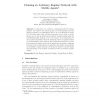Free Online Productivity Tools
i2Speak
i2Symbol
i2OCR
iTex2Img
iWeb2Print
iWeb2Shot
i2Type
iPdf2Split
iPdf2Merge
i2Bopomofo
i2Arabic
i2Style
i2Image
i2PDF
iLatex2Rtf
Sci2ools
ICDCIT
2005
Springer
2005
Springer
Cleaning an Arbitrary Regular Network with Mobile Agents
In this paper, we consider a contaminated network with an intruder. The task for the mobile agents is to decontaminate all hosts while preventing a recontamination and to do so as efficiently as possible. We study under what conditions and what cost a team of mobile agents can do this in synchronous arbitrary regular graphs using the breadth-first-search strategy. Due to the nature of the experiment we use a genetic algorithm to find the minimum number of agents required to decontaminate a given network. The results show that there is a relation between the degree, the size of the graph, and the number of starting locations of the mobile agents. in particular, this relation demonstrates the possibility of improvements in reducing the number of mobile agents used depending on the number of starting location in arbitrary regular graphs.
| Added | 27 Jun 2010 |
| Updated | 27 Jun 2010 |
| Type | Conference |
| Year | 2005 |
| Where | ICDCIT |
| Authors | Paola Flocchini, Amiya Nayak, Arno Schulz |
Comments (0)

